Art & Exhibitions
At Tony Salamé’s Aishti Foundation Art and Commerce Get Too Close for Comfort
It's hard to lose sight of the fact that you're looking at art inside a mall.
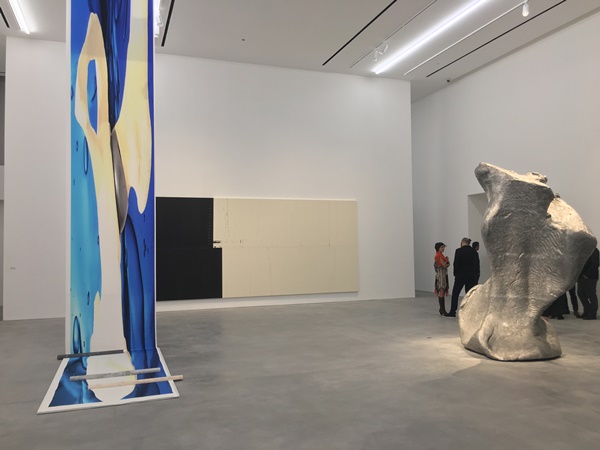
It's hard to lose sight of the fact that you're looking at art inside a mall.

Kevin McGarry

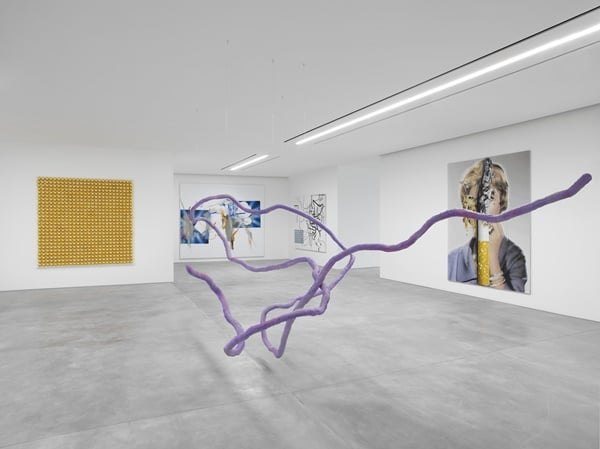
Installation view of “New Skin.”
Image: Guillaume Ziccarelli, courtesy of the Aishti Foundation
It was the most exotic question of every fake conversation in London. “After Paris are you going to Beirut?” A lot of people in Europe for Frieze and FIAC, mostly dealers, were afterwards heading to Lebanon, many for the first time. The occasion was the opening of collector Tony Salamé’s private museum the Aishti Foundation, which takes up a portion of a massive new mall on the Mediterranean about 20 minutes from downtown Beirut.
The museum and the mall (also called Aishti, a name synonymous with international luxury brands), share a footprint. They were built by British architect David Adjaye at the cost of roughly $100 million: five floors encased in a zigzag purplish, aluminum shell reminiscent of the 2015 Pantone color of the year, “Marsala.”
The inaugural exhibition, “New Skin,” curated by artistic director of the New Museum and director of the Trussardi Foundation Massimiliano Gioni, could be the most commercial institutional show I’ve seen on any continent. It’s a fallacy to write work off as inherently commercial or to discredit artists for being popular. Many in this show, from bankable talents like Urs Fischer and Danh Vo, to several, you might say, more boutique names like Simon Denny, R. H. Quaytman, and Andra Ursuta are as critically acclaimed as they are beloved by collectors.
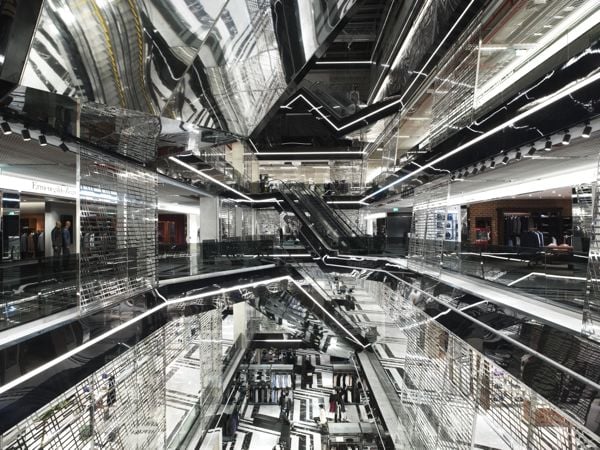
Aishti, interior of building.
Image: Courtesy of the Aishti Foundation.
However few here are represented by their best works, and as an exhibition, it is so banal and market-adherent that one may wonder what role a curator serves other than to license their own celebrity to confer a symbolic value on the endeavor. Not a single room has the alchemy to break the spell of feeling stuck inside an elegantly hung art fair (with a window in one gallery framing the mannequins of a Tom Ford shop, you cannot forget the space is inside a mall). The Aishti Foundation makes the Broad feel like MoMA.
The recently opened private museum founded by Edythe and Eli Broad has been roundly criticized for its obsessively blue chip sensibility. But the Broad has historical depth, as well as a sense of locality highlighted among a formidable international collection built over decades.
Mega-collector Tony Salamé began acquiring art in 2000 and pledged to build the foundation in 2013. More than three-quarters of the roughly 170 works in this show were made in the past five years, and fewer than two dozen come from the 20th Century. Of these, two-thirds are made by Italians such as Enrico Castellani, Lucio Fontana, and Giuseppe Penone (the rest are: four Günther Förg paintings, two Etel Adnan paintings, and individual works by Daniel Buren, Dan Flavin, and David Salle).
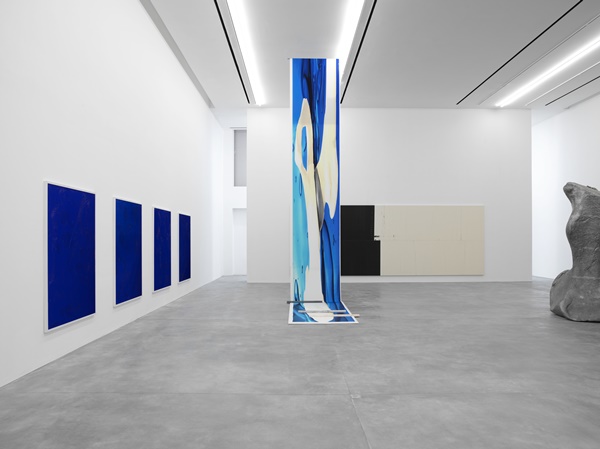
Installation view of “New Skin.”
Image: Guillaume Ziccarelli, courtesy of the Aishti Foundation
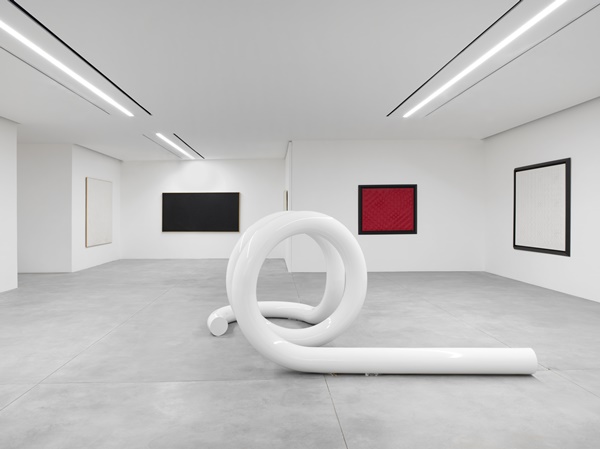
Installation view of “New Skin.”
Image: Guillaume Ziccarelli, courtesy of the Aishti Foundation
The link to Italy ostensibly articulates a “speculative lineage” between these artists’ experimentations with surface and “the digitally rendered compositions of many contemporary artists” today, according to Gioni’s introductory text. To me this premise is a bit too specific on one end and too generic on the other, making for a subjective glimpse of history watered down by a rote take on contemporaneity. As a position on where abstraction stands today, it’s flat, and not, as promised, in a way that evokes Castellani’s notion of the “concreteness of infinity.”
The elevators to the second floor, where the exhibition begins, open onto a quartet of paintings by dubious zombie formalist Ryan Sullivan. Within, there are plenty more American painters: Christopher Wool, Dan Colen, Josh Smith, Wade Guyton, Joe Bradley, Laura Owens. There are Rudolf Stingels, of course, and a long, crisply striped Richter painting perpendicular to a hall of corroded Walead Beshty copper panels.
There are Sterling Ruby sculptures of varying scales. You might think of them as “small,” “medium,” and “large.” For a cooler, more minimal look, there’s Tauba Auerbach or Seth Price; for something festive Carol Bove’s gaudily underwhelming vitrine-encased canvas adorned with peacock feathers. In form and in function, the specter of shopping haunts the entire display.

Installation view of “New Skin.”
Image: Guillaume Ziccarelli, courtesy of the Aishti Foundation
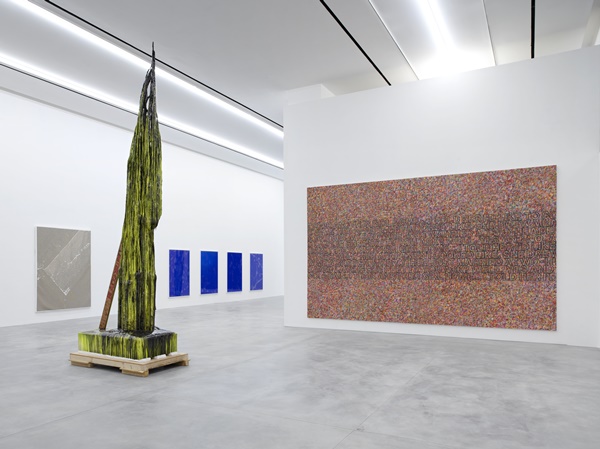
By my estimation the only living artist in the Aisthi exhibition who is not a staple at every Art Basel and Frieze is London-based Alice Channer, whose gimmicky sculpture New Skin—a monumental silkscreen of digitally scanned body lotion, draped from the ceiling—gave Gioni the name for his show. Some of its most memorable works were also included in Gioni’s Venice Biennale, among them Camille Henrot’s Lion-winning Grosse Fatigue and a room of wraithlike figures by Pawel Althamer.
Amid scores of Western artists on view, there are only five from Lebanon, and like most others in the show, they are assuredly good choices. In fact they are obvious choices: Mona Hatoum, Etel Adnan, lauded video artist Akram Zaatari, Sharjah Biennial standout Rayanne Tabet, and Paris-based Ziad Antar (who is with Almine Rech gallery). There are no artists from any other countries in the Middle East and there are none from Asia, Africa, or Latin America.
It’s entirely the Aishti Foundation’s prerogative to concentrate on work beyond its own region, but if the institution’s mission is to bring international art to Lebanon, it’s disappointing to see internationality exclusively represented by trendy Americans and Europeans. If the intended audience is a global one—and with the exception of Lebanese socialites, businesspeople and politicians, this seemed to be largely the case during the opening weekend—then with its opening show it is many time zones away from hitting the mark of being world class.
Salamé confirmed via email that an endowment has not been provided for the Aishti Foundation. Asked whether it can be assumed that it will fundraise from other sources, Salamé replied, “Yes, why not?” Three banks supported the opening of the building and inaugural exhibition.
It should be problematic for the New Museum to have its artistic director publicly aligned with a such a garish example of this phenomenon undermining the long term sustainability of public institutions, wherein would-be major patrons are opting to found their own exhibition spaces that compete with them for resources (though, the New Museum is not a collecting institution).
I can’t imagine that people other than those who count Aishti as a client would have come to Beirut for this if Gioni hadn’t lent his name to the enterprise. Indeed a whole weekend of festivities had been planned around the opening to dazzle visitors from abroad.
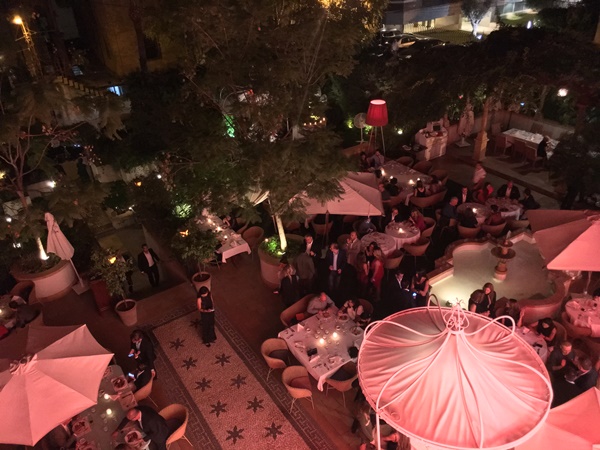
Dinner following the opening at the Metropolitan Art Society (MAS).
Image: Kevin McGarry
On Saturday there was an opening at the Metropolitan Art Society (MAS), sited on the ground floor of the 19th century Abdallah Bustros Palace, which Salamé founded in 2013 as an initiative to introduce contemporary art to the Lebanese public. The exhibition was curated by the New York-based art dealer and curator Jeffrey Deitch.
Pulling from the Aishti Collection, Deitch titled the MAS show “The Extreme Present,” after the new book by Shumon Basar, Douglas Coupland, and Hans Ulrich Obrist. It’s an energized selection of American artists—Kathryn Andrews, Ian Cheng, Alex Da Corte, Alex Israel, Josh Kline, Jamian Juliano-Villani, Avery Singer—and foreigners hardwired into the New York scene: Korakrit Arunanondchai, Ella Kruglyanskaya, and Bjarne Melgaard.
Melgaard’s coffee table, which looks inspired by the famed milk bar in the film A Clockwork Orange, is the centerpiece of a room decorated by Da Corte. It was originally part of Da Corte’s immersive project “Die Hexe,” which took over New York’s Luxembourg & Dayan gallery earlier this year. But divorced from its experiential hype, Da Corte’s contribution looks chintzy, and Arunanondchai’s big canvases look rushed, overpowering the more interesting video beside them. These are the weak links in an otherwise spirited, concise survey of some of the freshest perspectives from the homeland of late capitalism. It reminded me that Deitch, long absent from New York, is an expert with an inimitable eye, much preferable to the many unseasoned bozos who increasingly pose as impresarios as art and entertainment careen towards an inevitable supernova collision.
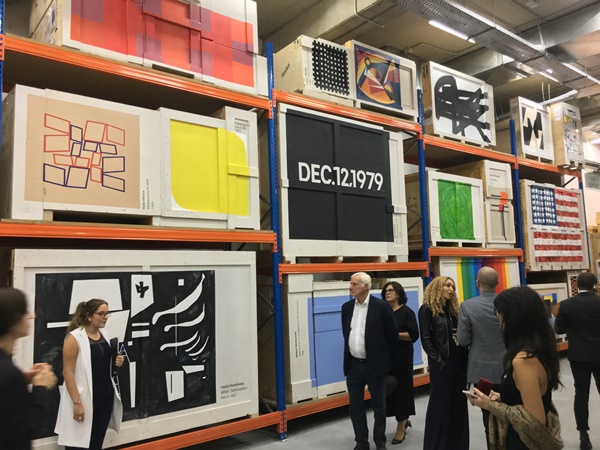
Collaborative installation by local artist Suha Traboulsi and Walid Raad.
Image: Kevin McGarry
The dinner that followed was oversubscribed, leading to an upstairs-downstairs situation where VIP guests elbowed for space in a lavish Lebanese restaurant on top of the gallery, overlooking a courtyard where others were luxuriating over a second, somehow inferior, dinner in the perfect Beirut breeze. Soon enough everyone was outside, including Lebanese fashion designer Elie Saab with an omnipresent coterie of well-dressed ladies, and an impish Maurizio Cattelan gallivanting with members of the Gulfie collective GCC.
Sunday began with apocalyptic rains. In a high rise hotel facing the sea, I worried I had woken up inside a hurricane, unable to tell water from wind as it smashed against the glass. After the storm subsided, a video was shared on Facebook that has, by now, been seen nearly a million times: hundreds if not thousands of bags and other articles of waste that had been dumped in the river as a Band-Aid solution to the city’s unresolved garbage strike were floating down a street. This occurred not far from the Aishti Foundation, whose seaside dinner party that night was scheduled to go until dawn.
A number of people from the local art community were omitted from the 2500 person guest list invited to the Aishti Foundation opening, and some locals who had been invited were boycotting it, not least because the guest of honor had been announced as Lebanon’s vilified interior minister Nouhad Al Machnouk.
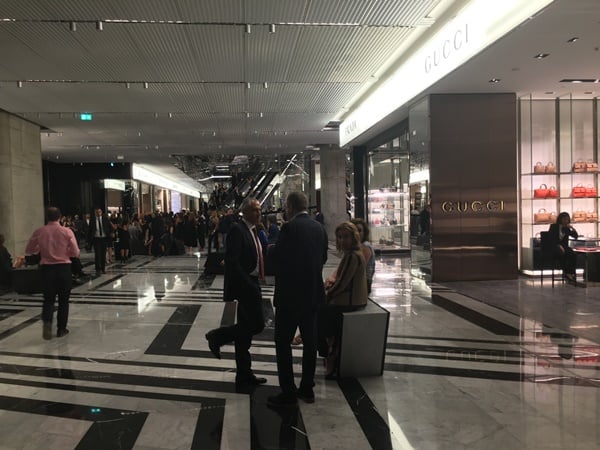
Aishti.
Image: Kevin McGarry
Machnouk has been assailed for being a key figure responsible for the continuation of the trash crisis. In August, he had given orders to beat and arrest protestors who were against river dumping and whose demonstrations were motivated by the fear of an overspill (precisely what happened that morning).
When asked why such a polarizing figure had been chosen as the guest of honor, Salamé told us over email that he invited the Prime Minister and all Ministers to the opening, and that the Prime Minister had delegated Machnouk to attend. Additionally, said Salamé, Machnouk is an expert and collector of Lebanese and Middle Eastern art.
Daily newspaper Al-Akhbar claims that sources in the interior ministry told them, “We partially gave the permission to close off the highway so the [Aishti opening] ceremony succeeds, so that people abroad see the image of Lebanon isn’t only garbage.”
That afternoon, before the opening, a detour was made to the secret location of what was purportedly the storage facility for the Aishti Collection, which housed a site-specific collaborative installation by local artist Suha Traboulsi and Walid Raad.
The project consisted of stacks of crates, each of which were empty but painted with an image of a work that had disappeared into bureaucracy years before. A trove of modern artworks by the likes of Carmen Herrera, On Kawara, and Wassily Kandinsky were acquired by the Lebanese government between 1952 and 1974 for the creation of a Museum of Modern Art. That museum was never established. But since then, unknown to the general public, many Lebanese politicians have secretly taken these works into their homes.
In an act of symbolic resistance, Traboulsi, the chief registrar of public collections in the Lebanese culture ministry, painted replicas of the missing paintings on their storage containers in the ministry. For this installation, Raad enlisted Traboulsi to recreate 37 of the 154 crates. The rest of the room was filled with the entire holdings of the Aishti Collection, carefully labeled with sheets of paper detailing what was inside each crate and where each work of art had been purchased. The crowd was invited to explore the storage at length. Both the provocation of the government and this act of extreme transparency were bold and fascinating gestures.
The implication of intermingling Raad and Traboulsi’s project with the collection might be that Aishti sees itself as Beirut’s long overdue museum of international art. But the most talked about thing on display was the fact that of approximately 2500 works in the collection, only two galleries from the Arab World—Sfeir Semler and Tannit, both in Beirut—facilitated any sales. This is consistent with other clues that the aim of the foundation is not to stimulate the art community that is already here. On the local level it’s an monumental merchandising project meant to impress and edify luxury consumers.
Salamé built his new Aishti in less than three years. In a country so unstable that it has operated without a president for half that time, this is truly an extraordinary feat. But marked by a fashion-forward nihilism, the foundation has yet to prove if it values art as anything more than a commodity.